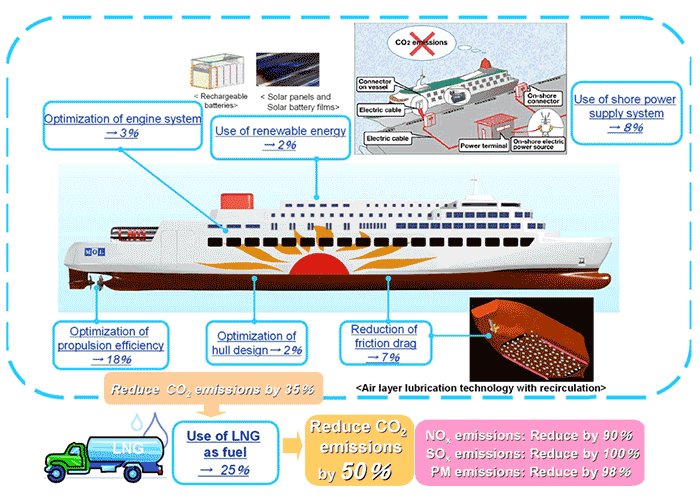- JP
- EN
MOL Completes Concept for Series of New-Generation Vessels
-Second Announcement: ISHIN-II Ferry-
December 02, 2009
TOKYO - Mitsui O.S.K. Lines, Ltd. (MOL, President: Akimitsu Ashida) today announced the completion of the concept for its second*1 in a series of next-generation vessels, which will be technically practical in the near future. The vessel is an environment-friendly ferry that can transport both cargo and passengers (ISHIN-II).
The ferry, which is an environment-friendly means of transport, plays a key role in the modal shift*2. It maximizes advancement of technologies already developed and adopted, will further reduce the environmental burden, and will enhance comfort for passengers. The features are as follows:
ISHIN-II three main features
(1)Use of LNG as fuel
- Under way:
- Cleaner exhaust gas and larger reduction of CO2 emissions*3
(2)Use of shore power supply system
- While in port, and at berth:
- Achieves zero emission by use of electricity supplied from shore and rechargeable batteries
Optimize electricity supplied from ferry berth, achieving zero emission while in port and at berth.
(3)Emphasis on comfort
Passengers can travel in freedom and comfort, with the catch phrase "Let's Stay Aboard." The design minimizes vibration and noise in passenger spaces, while maximizing comfort, convenience, and service quality for passengers.
*1 The first vessel in this series, the next-generation, environment-friendly car carrier ISHIN-I, was announced on September 10. MOL named the first concept vessel "ISHIN-I (ishin one)," which stands for "Innovations in Sustainability backed by Historically proven, INtegrated technologies."
*"ISHIN" is the Japanese word for a complete revitalization or reform
*2 An initiative to shift logistics from trucks and airplanes to more environment-friendly mode of transportation, such as vessels and railways, to reduce CO2 emissions, and so on.
(It is expected to ease traffic jams on roads, reduce traffic accidents, and ease the labor shortage caused by Japan's declining birthrate and aging population.)
*3 By introducing (1) and (2) and adopting a combination of new technologies, CO2 emissions will be reduced by 50%, NOx by 90%, SOx by 98-100%, and particulate matters (PM) such as soot , dust, and smoke by 98%, per voyage, compared to current MOL Group ferries.
« Reference Data » [Concept]

Concepts of main technologies and services that achieve the three main features
(Underlined parts are technologies using characteristics of ferry)
1. Use of LNG as fuel
ISHIN-II's main engine and power generation system will be fueled by liquefied natural gas (LNG), which generates over 20% less CO2 per thermal unit compared to the heavy fuel oil used by most conventional ferries. This results in a significant reduction in CO2 emissions.
Use of LNG as fuel reduces emissions of CO2, but also cuts emissions of NOx, SOx, and particulate matters (PM) such as soot, dust, and smoke, by about 90%, 98-100%, and 98% respectively. This significantly reduces the vessel's environmental burden.
2. Use of shore power supply system
Electricity will be supplied from an on-shore terminal to achieve zero emissions while in port. * Currently under study at Osaka Nanko Ferry Terminal.
3. Use of renewable energy
Solar battery films will be installed on all cabin windows to reduce light entering the cabins and solar power, a renewable energy source, will supply electricity.
Excess energy generated while under way will be stored in the high-capacity rechargeable lithium ion batteries. The batteries also supply part of the vessel's electricity needs in port, allowing it to achieve zero emissions while the vessel is in port or berthed.
4. Optimization of propulsion efficiency
- (1)Contra-rotating propeller system
ISHIN-II will have both a diesel engine and electric propulsion motor, with the propellers aligned front to back. The propellers spin in opposite directions; they evenly distribute the burden of propelling the ship, and the rear propeller absorbs the rotation energy of the front propeller. This greatly increases efficiency. - (2)The most advanced Propeller Boss Cap Fins (PBCF)
This MOL-developed energy-saving device has been adopted on more than 1,700 vessels all over the world. The most advanced model will be installed on the ISHIN-II vessels.
5. Reduction of friction drag
- (1)Air layer lubrication technology with recirculation
Minute bubbles of air are released from onboard the ship, creating an air layer that covers the ship bottom. This reduces friction drag. Collecting and recirculating the air will save even more energy. - (2)Ultra-low friction ship bottom coating
ISHIN-II will adopt the next-generation ultra-low friction ship bottom coating, in which smooth micro patterned indentations form on the painted surface, trapping water and reducing friction drag.
6. Efficiency of engine system
Electronic control optimizes fuel supply to the engine.
SOx in exhaust gas will be virtually eliminated by using LNG as fuel.
This allows for much more efficient retrieval and reuse of thermal energy from the exhaust gas, compared to conventional engines fueled by heavy fuel oil.
7. Optimization of hull design
A drastically improved hull form below the surface will enhance fuel efficiency.
8. Emphasis on comfort
ISHIN-II will maximize passenger comfort and convenience, as reflected by the catchphrase "Let's Stay Aboard." The smaller, more efficient engine will optimize propulsion efficiency, while minimizing noise and vibration. The vessel will also provide passenger-friendly facilities and passenger-focused services such as simplified IT-based boarding procedures and smoother loading and offloading of vehicles thanks to an exclusive rampway for passenger cars.
